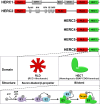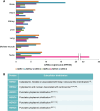Functional and pathological relevance of HERC family proteins: a decade later
- PMID: 26801221
- PMCID: PMC11108380
- DOI: 10.1007/s00018-016-2139-8
Functional and pathological relevance of HERC family proteins: a decade later
Abstract
The HERC gene family encodes proteins with two characteristic domains in their sequence: the HECT domain and the RCC1-like domain (RLD). In humans, the HERC family comprises six members that can be divided into two groups based on their molecular mass and domain structure. Whereas large HERCs (HERC1 and HERC2) contain one HECT and more than one RLD, small HERCs (HERC3-6) possess single HECT and RLD domains. Accumulating evidence shows the HERC family proteins to be key components of a wide range of cellular functions, including neurodevelopment, DNA damage repair, cell growth and immune response. Considering the significant recent advances made regarding HERC functionality, an updated review summarizing the progress is greatly needed at 10 years since the last HERC review. We provide an integrated view of HERC function and go into detail about its implications for several human diseases such as cancer and neurological disorders.
Keywords: HECT; HERC proteins; RCC1; RLD; Ubiquitin ligase.
Figures



Similar articles
-
HERCing: Structural and Functional Relevance of the Large HERC Ubiquitin Ligases.Front Physiol. 2019 Aug 7;10:1014. doi: 10.3389/fphys.2019.01014. eCollection 2019. Front Physiol. 2019. PMID: 31447701 Free PMC article. Review.
-
Evolution-Guided Structural and Functional Analyses of the HERC Family Reveal an Ancient Marine Origin and Determinants of Antiviral Activity.J Virol. 2018 Jun 13;92(13):e00528-18. doi: 10.1128/JVI.00528-18. Print 2018 Jul 1. J Virol. 2018. PMID: 29669830 Free PMC article.
-
The Emerging Roles of the HERC Ubiquitin Ligases in Cancer.Curr Pharm Des. 2018;24(15):1676-1681. doi: 10.2174/1381612824666180528081024. Curr Pharm Des. 2018. PMID: 29807510 Review.
-
Progressive Purkinje cell degeneration in tambaleante mutant mice is a consequence of a missense mutation in HERC1 E3 ubiquitin ligase.PLoS Genet. 2009 Dec;5(12):e1000784. doi: 10.1371/journal.pgen.1000784. Epub 2009 Dec 24. PLoS Genet. 2009. PMID: 20041218 Free PMC article.
-
HERC Ubiquitin Ligases in Cancer.Cancers (Basel). 2020 Jun 22;12(6):1653. doi: 10.3390/cancers12061653. Cancers (Basel). 2020. PMID: 32580485 Free PMC article. Review.
Cited by
-
LncRNA-Fendrr protects against the ubiquitination and degradation of NLRC4 protein through HERC2 to regulate the pyroptosis of microglia.Mol Med. 2021 Apr 15;27(1):39. doi: 10.1186/s10020-021-00299-y. Mol Med. 2021. PMID: 33858325 Free PMC article.
-
Regulation of the MDM2-p53 pathway by the ubiquitin ligase HERC2.Mol Oncol. 2020 Jan;14(1):69-86. doi: 10.1002/1878-0261.12592. Epub 2019 Nov 15. Mol Oncol. 2020. PMID: 31665549 Free PMC article.
-
Targeting E3 ubiquitin ligases and their adaptors as a therapeutic strategy for metabolic diseases.Exp Mol Med. 2023 Oct;55(10):2097-2104. doi: 10.1038/s12276-023-01087-w. Epub 2023 Oct 2. Exp Mol Med. 2023. PMID: 37779139 Free PMC article. Review.
-
Predictive and Prognostic Biomarkers for Lung Cancer Bone Metastasis and Their Therapeutic Value.Front Oncol. 2021 Oct 14;11:692788. doi: 10.3389/fonc.2021.692788. eCollection 2021. Front Oncol. 2021. PMID: 34722241 Free PMC article. Review.
-
Interferon-Induced HERC5 Inhibits Ebola Virus Particle Production and Is Antagonized by Ebola Glycoprotein.Cells. 2021 Sep 13;10(9):2399. doi: 10.3390/cells10092399. Cells. 2021. PMID: 34572049 Free PMC article.
References
Publication types
MeSH terms
Substances
LinkOut - more resources
Full Text Sources
Other Literature Sources

